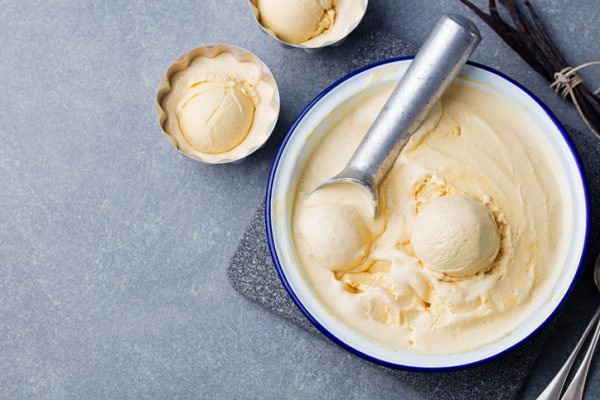DAY FIVE
Or is it? My headache has lifted and I feel more ‘myself’ although still quite achy. And, despite having had the best night’s sleep in nearly a week, I still feel sluggish and can’t face the thought of bread or dairy. I think it’s going to take more than a few days to remove this feeling (and look) of heaviness.
A pot of grass fed, Jersey, organic double cream bought from a Norfolk small-holding, has been lurking in the freezer waiting to be transformed into ice-cream – a treat that I thought I’d relish whilst on my dairy and gluten binge. Real ice-cream is nothing like commercially bought ice-cream. Made from a lethal mix of pasteurised and powdered milk and white sugar, and despite the addition of softeners to enable scooping from frozen, the taste and texture of the latter do not compare. Powdered milk is a source of dangerous oxidised cholesterol and neurotoxic amino acids, and is added to one per cent and two percent milk, low fat yoghurts, ice-creams and sour creams as its mucopolysaccharied slime provides body to compensate for the lack of fat.
But even the best quality ice-cream is not whetting my appetite. The thought of it gives me a slightly sickish feeling. Since Jersey milk contains the less provocative A2 casein, I had regarded this as more of a treat as I knew, for the purposes of accuracy, I would also have to incorporate some A1 milk. A1 casein is found in milk from Friesians and many other breeds, whereas A2 is found in goat’s, sheep’s, Jersey and Guernsey’s, although due to cross-contamination you cannot always be certain.
But the thought of drinking any milk – something I have never been able to do unless disguised and ice-cold – reminded me of my childhood when, as a 1950’s school child I was forced by law to consume one third of a pint of the stuff daily. Having always been repulsed by milk, this lukewarm liquid on the verge of rancidity from the playground sunshine, made me dread the morning break. My face, shining like a beacon and red and smarting from eczema, stands out as one of my strongest primary school memories. And having to get this down every day counts as one of my childhood traumas – and there many, mostly doctor-related – when I tried to get away with not quite finishing the bottle. As opting out was not an option, in desperation my mother sent me to school with flavoured straws, which were filled with either a chocolate or strawberry sugared powder that I used to disguise the nauseating taste and smell. When the Thatcher government removed this privilege in the 1980’s there was an outcry.
Despite not having eaten any gluten or dairy, and having only had a raw smoothie and salad with some seed granola yesterday, I have had no bowel movement today. I don’t know how long it will take until things get back to my normal three times a day habit, but I don’t know if I can face anything other than a light, raw diet today either. This has come as a surprise as I had anticipated secretly enjoying foods like bread and cream, and had even feared becoming addicted to them.
Never having been prone to constipation, I was also surprised at how sensitive the bowel is to what we eat. Since the nervous and digestive systems are intricately linked – in fact they aren’t separate systems at all – the bowel reacts to any emotional and physiological change. This is why many peoples’ bowels pack up completely when travelling. In my book, Go Paleo – Feeding the Urban Caveman I explain how difficult grains and dairy are to digest. And if my digestion can be upset by small amounts of these foods, what are the effects on the population at large for whom these foods are dietary staples? The reality is that eating this sort of diet places a huge strain on the body. It uses up energy and enzyme reserves which, over time, gradually run out. Since grains are not noted for their nutrient density and pasteurised dairy provides little in the way of nutrition, the ever-widening deficit between the two as we age is not the way to ensure a healthy and active retirement.
I began this blog as a way of monitoring my reaction over a ten-day period to the reintroduction of gluten and dairy. But what is becoming evident is that my body is not going to cooperate in this experiment without a fight. And I am not sure I want to do battle with it as it can serve up some pretty unpleasant symptoms. So, I am now moving towards the idea of only eating gluten and dairy once every three or four days. We know from the work of Dr Tom O’Bryan that eating gluten every two months can keep the antibody response alive, but would eating it every few days be enough to stimulate the production of antibodies in the first place? After all, food rotation is based on the theory that only eating a food once every four days will avert a response, but whether this is enough to prevent antibody production or is simply a means of controlling symptoms I am not sure.
I have emailed the lab with this very question. In the meantime, I’m keeping off the heavy stuff!



